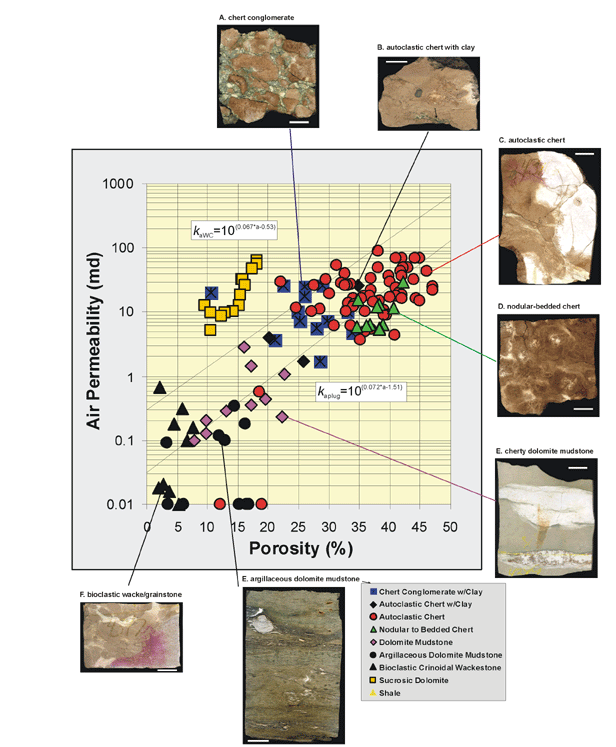
Characterization of Mississippian Osage Chat in South-Central
Kansas
Kansas Geological Survey
Open-file Report 2002-50

|
|
Kansas Geological Survey Open-file Report 2002-50 |

Routine air permeability values of chat whole core and core
plugs, range from <0.01 md to 700 md. Linear regression analysis
indicates that insitu Klinkenberg permeabilities may be predicted
within approximately a factor of 2 using the relation:
ki = 10(1.15*logka-0.33
Figure illustrates the log-linear relationship between routine air permeability (ka) and routine porosity (fa). Each of the Chat lithofacies generally occupy a unique porosity-permeability region.
Autoclastic cherts exhibit the maximum porosity and permeability with porosities ranging from 25-50% and permeabilities >5 md. Permeability variance within this lithofacies at any given porosity can be attributed primarily to: 1) sponge-spicule mold content, 2) small vug content, believed to result from both sponge-spicule dissolution and dissolution of microporous chert, 3) enhanced porosity development at clast boundaries, and 4) circum- and intraclast microfracturing.
Both the chert conglomerate and autoclastic chert with clay infill facies exhibit routine air permeabilities at any given porosity as much as a factor of 2 to 5 times greater than the regression trend for the autoclastic chert. Both circum- and trans-clast cracks enhance permeability in these facies. However, the clay/mudstone infill decreases porosity and results in a decrease in larger-scale permeability compared to permeabilities of the chert clasts alone.
Both visible vuggy porosity, bioclastic moldic porosity, and open intraclast desiccation cracks are most evident in the chert conglomerates and are less evident in the autoclastic cherts. Porosities below 20% in the chert conglomerates are related both to increasing clay-infill content and increasing content of dense chert clasts.
At any given porosity the nodular to bedded chert facies exhibits permeabilities approximately a factor of 2 less than the autoclastic chert facies. The lower permeability of this facies appears to be related to lower vug content, less porosity development at clast boundaries, and an absence of circum-clast microfracturing.
The cherty dolomite mudstones, and argillaceous dolomite mudstones can exhibit porosities up to 22% but due to the small grain and pore size, display routine air permeabilities of less than 1md.
The bioclastic crinoidal wacke/grainstones are highly cemented and cluster below 5% porosity and generally exhibit permeabilities less than 0.01 md. Where this facies and the bioclastic wacke/grainstones are brecciated, fractured, or churned with cherty facies, permeability may be slightly enhanced but is still less than 0.3 md.
Bates Field sucrosic dolomites are not cherty but represent the evolution of the dolomite mudstones in a laterally equivalent setting where chert replacement has not occurred. The development of sucrosic dolomites does not significantly increase the porosity above that found in dolomite mudstones but results in permeabilities that are two orders of magnitude greater. Properties of patchy sucrosic dolomite within the cherty dolomite mudstone facies appear to exhibit similar properties when similar grain sizes develop.
|
|